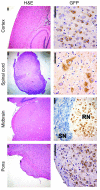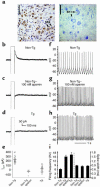Enhanced neuronal excitability in the absence of neurodegeneration induces cerebellar ataxia
- PMID: 14966567
- PMCID: PMC338266
- DOI: 10.1172/JCI20216
Enhanced neuronal excitability in the absence of neurodegeneration induces cerebellar ataxia
Abstract
Cerebellar ataxia, a devastating neurological disease, may be initiated by hyperexcitability of deep cerebellar nuclei (DCN) secondary to loss of inhibitory input from Purkinje neurons that frequently degenerate in this disease. This mechanism predicts that intrinsic DCN hyperexcitability would cause ataxia in the absence of upstream Purkinje degeneration. We report the generation of a transgenic (Tg) model that supports this mechanism of disease initiation. Small-conductance calcium-activated potassium (SK) channels, regulators of firing frequency, were silenced in the CNS of Tg mice with the dominant-inhibitory construct SK3-1B-GFP. Transgene expression was restricted to the DCN within the cerebellum and was detectable beginning on postnatal day 10, concomitant with the onset of cerebellar ataxia. Neurodegeneration was not evident up to the sixth month of age. Recordings from Tg DCN neurons revealed loss of the apamin-sensitive after-hyperpolarization current (IAHP) and increased spontaneous firing through SK channel suppression, indicative of DCN hyperexcitability. Spike duration and other electrogenic conductance were unaffected. Thus, a purely electrical alteration is sufficient to cause cerebellar ataxia, and SK openers such as the neuroprotective agent riluzole may reduce neuronal hyperexcitability and have therapeutic value. This dominant-inhibitory strategy may help define the in vivo role of SK channels in other neuronal pathways.
Figures







Comment in
-
Into the depths of ataxia.J Clin Invest. 2004 Feb;113(4):505-7. doi: 10.1172/JCI21092. J Clin Invest. 2004. PMID: 14966557 Free PMC article.
References
-
- Rosenberg RN. The genetic basis of ataxia. Clin. Neurosci. 1995;3:1–4. - PubMed
-
- Klockgether T, Dichgans J. The genetic basis of hereditary ataxia. Prog. Brain Res. 1997;114:569–576. - PubMed
-
- Grusser-Cornehls U, Baurle J. Mutant mice as a model for cerebellar ataxia. Prog. Neurobiol. 2001;63:489–540. - PubMed
-
- Trouillas P, et al. International Cooperative Ataxia Rating Scale for pharmacological assessment of the cerebellar syndrome. The Ataxia Neuropharmacology Committee of the World Federation of Neurology. J. Neurol. Sci. 1997;145:205–211. - PubMed
-
- Figueroa KP, et al. Association of moderate polyglutamine tract expansions in the slow calcium-activated potassium channel type 3 with ataxia. Arch. Neurol. 2001;58:1649–1653. - PubMed
Publication types
MeSH terms
Substances
LinkOut - more resources
Full Text Sources
Other Literature Sources
Medical
Molecular Biology Databases
Miscellaneous

